Timolol 0.5%W/V Eye Drops Solution
Timoptol® 0.5%w/v Eye Drops Solution/ Timolol 0.5%w/v Eye Drops Solution
(Timolol maleate)
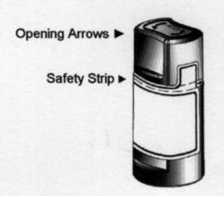
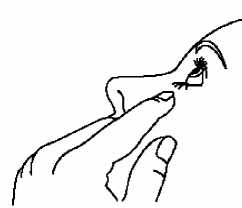

Your medicine is known by any of the above names, but will be referred to as Timoptol throughout this leaflet. The other strength “0.25” is also available.
Patient Information Leaflet
Read all of this leaflet carefully before you start using this medicine.
• Keep this leaflet. You may need to read it again.
• If you have any further questions, ask your doctor or pharmacist.
• This medicine has been prescribed for you. Do not pass it on to others. It may harm them, even if their symptoms are the same as yours.
• If any of the side effects gets serious, or if you notice any side effects not listed in this leaflet, please tell your doctor or pharmacist.
In this leaflet:
1) What Timoptol is and what it is used for
2) Before you use Timoptol
3) How to use Timoptol
4) Possible side effects
5) How to store Timoptol
6) Further information
1) What Timoptol is and what it is used for
Timoptol contains a substance called timolol which belongs to a group of medicines called beta-blockers. Timolol lowers the pressure in your eye(s). It is used to treat glaucoma, when the pressure in the eye is raised.
2) Before you use Timoptol Do not use Timoptol if:
• you are allergic (hypersensitive) to timolol, beta-blockers or any of the other ingredients of Timoptol (see section 6 for Further Information)
• you have now or have had in the past respiratory problems such as asthma, severe chronic obstructive bronchitis (severe lung disease which may cause wheeziness, difficulty in breathing and/or long-standing cough)
• you have heart problems
• slow heart beat
• disorders of heart rhythm (irregular heart beats)
• heart failure
- “cardiogenic shock” - a serious heart condition caused by very low blood pressure, which may result in the following symptoms: dizziness and lightheadedness, fast pulse rate, white skin, sweating, restlessness, loss of consciousness.
If you are not sure whether you should use Timoptol talk to your doctor or pharmacist.
Take special care with Timoptol
Before you use this medicine tell your doctor if you have now or have had in the past
• coronary heart disease (symptoms can include chest pain or tightness, breathlessness or choking), heart failure
• low blood pressure
• disturbances of heart rate such as slow heart beat
• breathing problems, asthma or chronic obstructive pulmonary disease
• poor blood circulation disease (such as Raynaud's disease or Raynaud's syndrome)
• diabetes as timolol may mask signs and symptoms of low blood sugar
• overactivity of the thyroid gland as timolol may mask signs and symptoms
• you wear soft contact lenses. Your eye drops contain a preservative which can be deposited on soft contact lenses. It is important that your lenses are removed before using your eye drops and not put back into your eyes for 15 minutes.
Tell your doctor before you have an operation that you are using Timoptol as timolol may change effects of some medicines used during anaesthesia.
If your eye becomes irritated or any new eye problems come on, talk to your doctor straight away. Eye problems could include redness of the eye or swelling of the eyelids (see Section 4: Possible Side Effects).
If you suspect that Timoptol is causing an allergic reaction or hypersensitivity (for example, skin rash, or redness and itching of the eye), stop using Timoptol and contact your doctor immediately.
Tell your doctor if:
• you get an eye infection
• you injure your eye or have an operation on it
• your eye problems get worse or you get any new symptoms.
Use in children and adolescents
There is only very limited data available on the use of timolol in infants and children. For example, in one small clinical study, timolol, the active ingredient in Timoptol eye drops, has been studied in infants and children aged 12 days to 5 years, who have elevated pressure in the eye(s) or have been diagnosed with glaucoma. For more information, talk to your doctor.
Timoptol should generally be used with caution in young patients. In newborns, infants and younger children Timoptol should be used with extreme caution. If coughing, wheezing, abnormal breathing or abnormal pauses in breathing (apnoea) occur, the use of the medication should be stopped immediately. Contact your doctor as soon as possible. A portable apnoea monitor may also be helpful.
Using other medicines
Timoptol can affect or be affected by other medicines you are using, including other eye drops for the treatment of glaucoma. Tell your doctor if you are using or intend to use medicines to lower blood pressure, heart medicine or medicines to treat diabetes. Please tell your doctor or pharmacist if you are taking or have recently taken any other medicines, including other eye drops or medicines obtained without a prescription.
It is important to tell your doctor before using Timoptol if you are taking one or more of the following medicines:
• a calcium antagonist, such as nifedipine, verapamil or diltiazem, often used to treat high blood pressure, angina, an abnormal heartbeat or Raynaud's syndrome
• digoxin, a medicine used to relieve heart failure or treat abnormal heartbeat
• medicines known as catecholamine-depleting agents, such as rauwolfia alkaloids or reserpine, used for high blood pressure
• medicines called pressor amines, such as adrenaline used to treat severe allergic reaction
• quinidine (used to treat heart conditions and some types of malaria)
• antidepressants known as fluoxetine and paroxetine.
• clonidine, a medicine used to treat high blood pressure
• other beta-blockers taken by mouth or used as eye drops, because they belong to the same group of medicines as Timoptol and could have an additive effect.
Pregnancy and breast-feeding
Ask your doctor for advice before taking any medicine.
Use in pregnancy
Do not use Timoptol if you are pregnant unless your doctor considers it necessary.
Use in breast-feeding
Do not use Timoptol if you are breast-feeding. Timolol may get into your milk. Ask your doctor for advice before taking any medicine during breastfeeding.
Driving and using machines
There are possible side effects associated with Timoptol, such as dizziness, tiredness and changes in your eyesight, such as blurred vision, drooping of the upper eyelid (making the eye stay half closed), double vision which may affect your ability to drive and/or operate machinery. Do not drive and/or operate machinery until you feel well and your vision is clear.
3) How to use Timoptol
Always use Timoptol eye drops solution exactly as your doctor has told you. You should check with your doctor or pharmacist if you are not sure. The doctor will decide how many drops you should take each day and how long you should use them.
The usual dose is one drop in the affected eye(s) twice each day:
• one in the morning
• one in the evening.
Do not change your usual dose without talking to your doctor.
Do not allow the tip of the container to touch the eye or areas around the eye. It may become contaminated with bacteria that can cause eye infection leading to serious damage of the eye, even loss of vision. To avoid possible contamination of the container, keep the tip of the container away from contact with any surface.
Instructions for use.
It is recommended that you wash your hands before putting in your eye drops.
1. Before using the medication for the first time, be sure the Safety Strip on the front of the bottle is unbroken. A gap between the bottle and the cap is normal for an unopened bottle
2. Tear off the safety strip to break the seal.
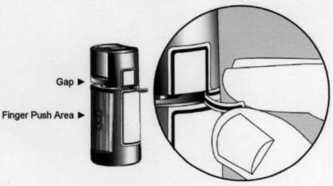
3. To open the bottle, unscrew the cap by turning as indicated by the arrows on top of the cap. Do not pull the cap directly up and away from the bottle. Pulling the cap directly up will prevent your dispenser from operating properly.
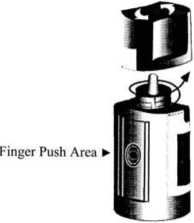
4. Tilt your head back and pull your lower eyelid down slightly to form a pocket between your eyelid and your eye.
5. Invert the bottle, and press lightly with your thumb or first finger over the ‘Finger-Push Area' as shown until a single drop is dispensed into your eye, as directed by your doctor.
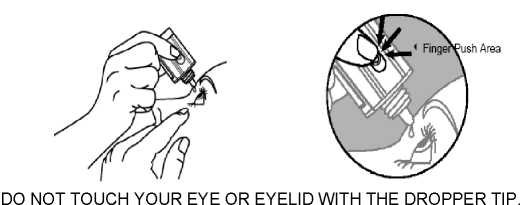
6. After using Timoptol, press a finger into the corner of your eye, by the nose for 2 minutes. This helps to stop timolol getting into the rest of your body.
Ophthalmic medications, if handled improperly, can become contaminated by common bacteria known to cause infections. Serious damage to the eye and subsequent loss of vision may result from using contaminated ophthalmic medications. If you think your medication may be contaminated, or if you develop an eye infection, contact your doctor immediately concerning continued use of this bottle.
7. If drop dispensing is difficult after opening for the first time, replace the cap on the bottle and tighten (do not overtighten) and then remove by turning the cap in the opposite direction as indicated by the arrows on top of the cap
8. Repeat steps 4 & 5 with the other eye if instructed to do so by your doctor.
9. Replace the cap by turning until it is firmly touching the bottle. The arrow on the left side of the cap must be aligned with the arrow on the left side of the bottle label for proper closure. Do not overtighten or you may damage the bottle and cap.
10. The dispenser tip is designed to provide a single drop; therefore do NOT enlarge the hole of the dispenser tip.
11. After you have used all doses there will be some Timoptol left in the bottle. You should not be concerned since an extra amount of Timoptol has been added and you will get the full amount of Timoptol that your doctor has prescribed. Do not attempt to remove the excess medicine from the bottle.
Use in children and adolescents
Before you or your child starts to take Timoptol, your doctor or your child's doctor will have carried out a detailed medical examination and decided whether or not this medicine is suitable. You or your child, especially a newborn, should be closely monitored for one to two hours after the first dose and carefully monitored for any signs of side effects until surgery is carried out.
Method of administration:
One drop only of Timoptol should be instilled into the affected eye(s) each time. Follow the “Instructions for Use” above when administering the eye drops. After instillation keep the eyes closed for as long as possible (e.g. 3 - 5 minutes) and apply pressure to the corner of the eye closest to the nose to prevent the eye drops spreading throughout the body.
Duration of treatment:
Your doctor or your child's doctor will decide for how long the eye drops will be needed.
If you use more Timoptol than you should
If you put too many drops in your eye or swallow any of the drops, you may:
• have a headache
• feel dizzy or light-headed
• have difficulty breathing
• chest pain
• feel that your heart rate has slowed down.
If this happens, contact your doctor immediately.
If you forget to use Timoptol
It is important to take Timoptol as prescribed by your doctor.
• If you miss a dose, use the drops as soon as possible.
• If it is almost time for the next dose, skip the missed dose and take the next dose at the usual time.
• Do not take a double dose to make up for the forgotten dose.
If you stop using Timoptol
If you want to stop using this medicine talk to your doctor first. If you have any further questions on the use of this product, ask your doctor or pharmacist.
4) Possible side effects
Like all medicines Timoptol can cause side effects, although not everybody gets them.
You can usually carry on taking the drops, unless the effects are serious. If you're worried, talk to a doctor or pharmacist. Do not stop using Timoptol without speaking to your doctor.
Like other medicines applied into eyes, timolol is absorbed into the blood. This may cause similar side effects as seen with intravenous and/or oral beta-blocking agents. Incidence of side effects after topical ophthalmic administration is lower than when medicines are, for example taken by mouth or injected. Listed side effects include reactions seen within the class of beta-blockers when used for treating eye conditions.
If you develop allergic reactions including swelling beneath the skin that can occur in areas such as the face and limbs, and can obstruct the airway which may cause difficulty swallowing or breathing, hives or itchy rash, localized and generalized rash, itchness, severe sudden life-threatening allergic reaction, stop taking your eyes drops and seek medical attention immediately.
Low blood glucose levels.
Difficulty sleeping (insomnia), depression, nightmares, memory loss.
Fainting, stroke, reduced blood supply to the brain, increases in signs and symptoms of myasthenia gravis (muscle disorder), dizziness, unusual sensations like tingling or pins and needles, and headache.
Signs and symptoms of eye irritation (e.g. burning, stinging, itching, tearing, redness), inflammation of the eyelid, inflammation in the cornea, blurred vision and detachment of the layer below the retina that contains blood vessels following filtration surgery which may cause visual disturbances, decreased corneal sensitivity, dry eyes, corneal erosion (damage to the front layer of the eyeball), drooping of the upper eyelid (making the eye stay half closed) double vision, sensitivity to light, discharge from the eye, pain in the eye.
Ringing sound in the ears.
Slow heart rate, chest pain, palpitations, oedema (fluid build up), changes in the rhythm or speed of the heartbeat, congestive heart failure (heart disease with shortness of breath and swelling of the feet and legs due to fluid build up), a type of heart rhythm disorder, heart attack, heart failure.
Low blood pressure, fainting, interference with the blood supply to the brain which may lead to a stroke, Raynaud's phenomenon, cold hands and feet, limping because there is a reduced blood supply to your legs.
Constriction of the airways in the lungs (predominantly in patients with preexisting disease), difficulty breathing, shortness of breath, wheezing, cough.
Taste disturbances, nausea, indigestion, diarrhoea, dry mouth, abdominal pain, vomiting.
Sexual dysfunction, decreased sex drive, decreased libido. In men a condition which affects your penis called Peyronie's disease. The signs may be abnormal curve, pain or hardening of the tissue of your penis.
Hair loss, skin rash with white silvery coloured appearance (psoriasiform rash) or worsening of psoriasis, skin rash, itching.
Muscle weakness/tiredness, muscle pain not caused by exercise. A condition called lupus (systemic lupus erythematosus).
Ask your doctor or pharmacist for more information about the side effects. Both have a more complete list of side effects.
Reporting of side effects
If you get any side effects, talk to your doctor or pharmacist. This includes any possible side effects not listed in this leaflet. You can also report side effects directly via the Yellow Card Scheme (Website: www.mhra.gov.uk/yellowcard). By reporting side effects you can help provide more information on the safety of this medicine.
5) How to store Timoptol
• Keep your eye drops out of the sight and reach of children.
• Make sure the container is properly closed.
• Store in a dry place below 25°C. Store the bottle in the outer carton as this product is sensitive to light.
• Do not use the bottle after it has been open for 28 days or if your eye drops are past the expiry date which is clearly marked on the box.
• Medicines should not be disposed of via wastewater or household waste. Ask your pharmacist how to dispose of medicines no longer required. These measures will help to protect the environment.
6) Further information What Timoptol contains
Timoptol 0.5% Eye Drops contain the active ingredient Timolol (as maleate) 0.5% w/v.
Timoptol 0.5% Eye Drops also contain the following:
benzalkonium chloride, monosodium phosphate, anhydrous disodium
phosphate and purified water.
What Timoptol looks like and contents of the pack
Timoptol 0.5% Eye Drops are packaged in cartons containing one 5ml bottle of clear colourless to light yellow ophthalmic solution, and are ONLY for use in the eyes.
PL 10383/0348 |pOM
Who makes and repackages your medicine?
Your medicine is manufactured by Laboratoires Merck Sharp & Dohme-Chibret. Mirabel Plant, Riom, France. Procured from within the EU by Necessity Supplies Ltd., Northolt, Middlesex, UB5 5QS and repackaged by Product Licence Holder: Primecrown Ltd, 4/5 Northolt Trading Estate, Belvue Road, Northolt, Middlesex, UB5 5QS.
Leaflet date: 08.04.2016
Further information about glaucoma is available from:
International Glaucoma Association (IGA)
15A Highpoint Business Village
Henwood, Ashford
Kent, TN24 8DH
Tel: 01233 648170
E-mail: info@iga.org.uk
Registered Charity number 274681.
(The IGA is an independent charity organisation which helps glaucoma patients and their relatives, and is not associated with Merck Sharp & Dohme Limited or Primecrown Ltd.)
Alternatively, if you or someone you know has problems with their vision, and you require further advice or information, please contact:
For the UK: the Royal National Institute for the Blind (RNIB) Helpline on 0303 123 9999, Monday to Friday 8.45am to 6pm and Saturday 9am to 4pm.
(The RNIB is an independent UK charity and is not associated with Merck Sharp & Dohme Limited).
For Ireland: National Council for the Blind of Ireland, Whitworth Road, Drumcondra, Dublin 9. Tel: 01 8307033 or Fax: 01 8307787 charity registration number: CHY 4626
(The National Council for the Blind of Ireland is an independent Irish charity and is not associated with Merck Sharp & Dohme Limited).
Timoptol® is a registered Trade Mark of Merck Sharp & Dohme Corp., Whitehouse Station, NJ, USA.